Crisp in Summer, Chewy in Winter: The Freshness of Kaga-Renkon Lotus Root Lies in Its Earthy Coating and Rustic Patina.
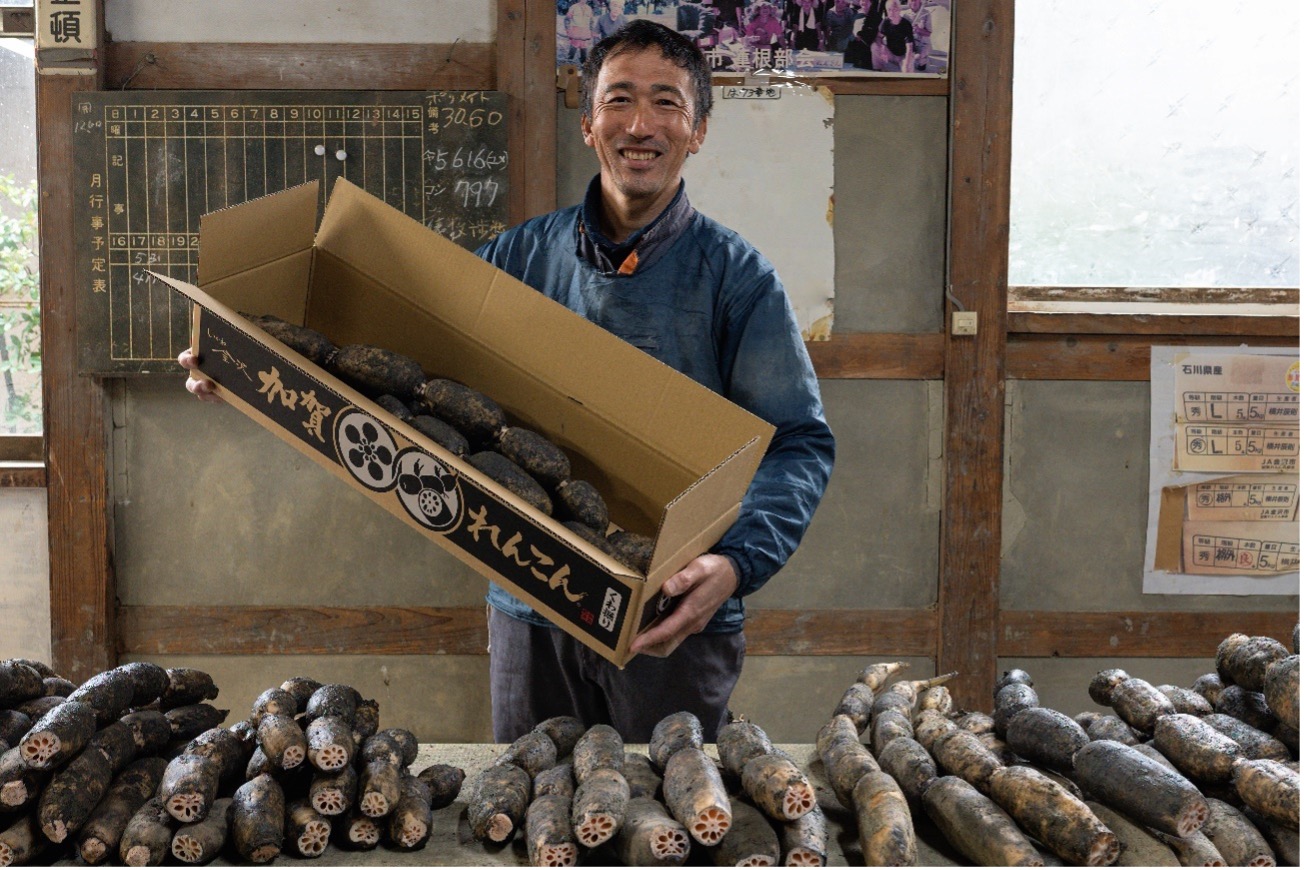
Consumed by High-Ranking Samurai During the Feudal Era.
The charm of “Kaga-renkon lotus root” lies in its chewy texture and strong stickiness. In addition to tempura and steamed dishes, a traditional local dish called renmushi—grated and steamed lotus root topped with warm sweet bean paste—is also popular. In summer, wagashi shops sell “hasune kan,” a jelly made from grated lotus root and agar. In summer, the new-season lotus roots have a crisp texture, while in winter, when it’s fully matured, it becomes even more “mochi-like,” allowing you to enjoy different textures depending on the season.
The history of cultivating “Kaga-renkon lotus root” dates back to the era of the fifth lord of the Kaga domain, Maeda Tsunanori. The high-ranking samurai of the Kaga domain called it “Hasu no ne” and began to use it for food (and medicinal purposes). Eventually, the area around Oohi Town in Kanazawa City (Kosaka District) became the main production area. In 1861, toward the end of the Edo period, it is said that it began to be publicly cultivated as a product of Kaga Province under the name “Oohi Renkon.”
The “Oohi Renkon” is a short, small variety of lotus root that grows along the underground area about 1 meter deep, and it is also called “Jibasu.” It was difficult to harvest, so the yield was low, but it is said to have been cultivated until the mid-Meiji period. In the 1890s, its cultivation for food became widespread, and it began to be called “Kosaka Renkon.”
Around this time and into the Taisho era, dedicated farmers such as Motooka Michiji, his son Motooka Takichi, and Yohei Omote worked tirelessly to introduce new varieties of lotus root. Motooka Takichi later named it “Kaga-renkon,” and it began to be shipped to market under that name. Even after the Showa era began, various varieties were introduced. In the mid-1960s, “Shina Shirobana,” a selected and cultivated variety derived from “Shina Renshu,” was introduced and took root, leading to the present day.
The cultivation area of “Kaga-renkon lotus root” currently spans from the Kosaka district in Kanazawa City, extending to the Saida, Morimoto, Kahokugata reclamation area, and as far as Tsubata Town. The lotus fields in this region, which bloom in the summer, have become a symbol of Kanazawa’s seasonal landscape.
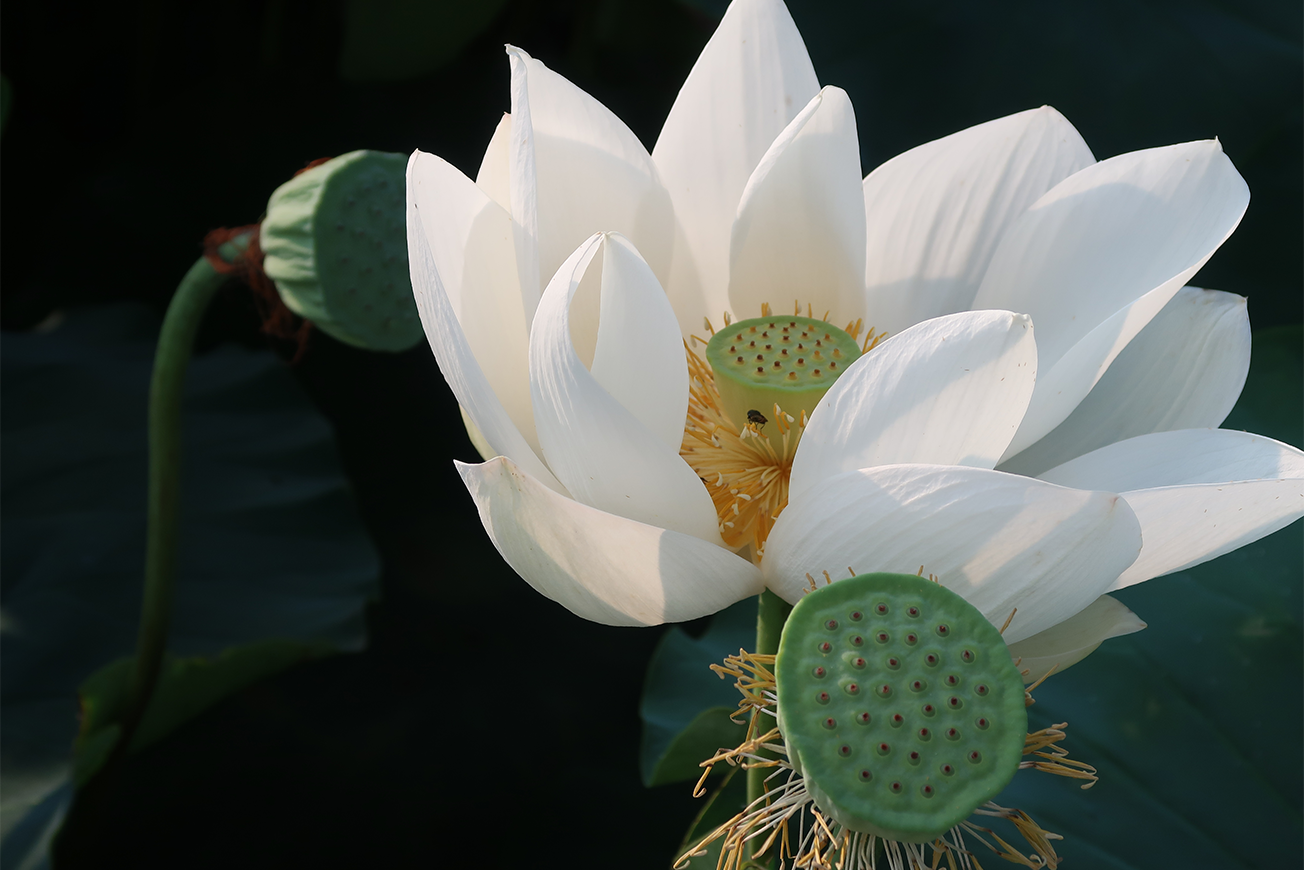
The “JA Kanazawa City Kaga-renkon Association” (hereinafter referred to as the “Kaga-renkon Association”), consisting of 45 farmers, is committed to environmentally friendly farming practices. In addition, “Kaga-renkon lotus root” is cultivated using traditional methods, with an emphasis on avoiding chemical substances such as pesticides and chemical fertilizers. Some members of the association are also certified for special cultivation or organic JAS.
From late April to late May, lotus roots are planted as seeds. By mid-July, they begin to grow vigorously, producing large leaves and beautiful flowers. The stems eventually develop into lotus roots with underground nodes. The new-season lotus roots are harvested in late August, with subsequent harvests continuing until late May of the following year.
Tatsunori Yokoi, president of the “Kaga-renkon Association,” explains that the growing season before harvest is particularly challenging.
“Because they grow underground, you can’t really tell how they’re doing until you actually dig them up. Even if the leaves are growing well, it’s possible that the roots themselves are no good. Simply following growing guidelines isn’t enough. Just as each person’s health condition is different, each field has its own unique condition, so adjustments are necessary.”
The greatest threat to “Kaga-renkon lotus root” is undoubtedly typhoons. If the tall stems with large leaves sway, the growth of the lotus roots underground will stop. In addition, if strong winds break the stems and allow water to seep inside, the lotus roots can rot. To counter this, farmers take measures to grow thicker stems that can withstand typhoons. However, Kahokugata is naturally a windy area. Nevertheless, because the lotus roots are grown in this heavy clay soil, they develop a thick, fine-textured flesh with a unique stickiness and chewiness not found in lotus roots from other regions.
Surprising Harvesting Methods: Hammering Ice When Necessary...
There are two methods of harvesting. One is the traditional “kuwa-bori” method, where large hoes are used to dig up the soil while draining the water from the field. The other is the “mizu-bori” method, where harvesting is done with the field kept filled with water, utilizing water pressure. The mizu-bori method, developed to improve efficiency, is primarily used in the water-rich fields of Kahokugata.
Currently, about 15 farmers in the “Kaga-renkon Association” still use the traditional “kuwa-bori” method of harvesting. Of the approximately 600 tons produced annually by the association, only about 10% is harvested using the “kuwa-bori” method. It is said that the efficiency of “kuwa-bori” is about 20% higher than that of “mizu-bori,” but due to the aging of the farming population, more farmers are now turning to “mizu-bori” for harvesting.
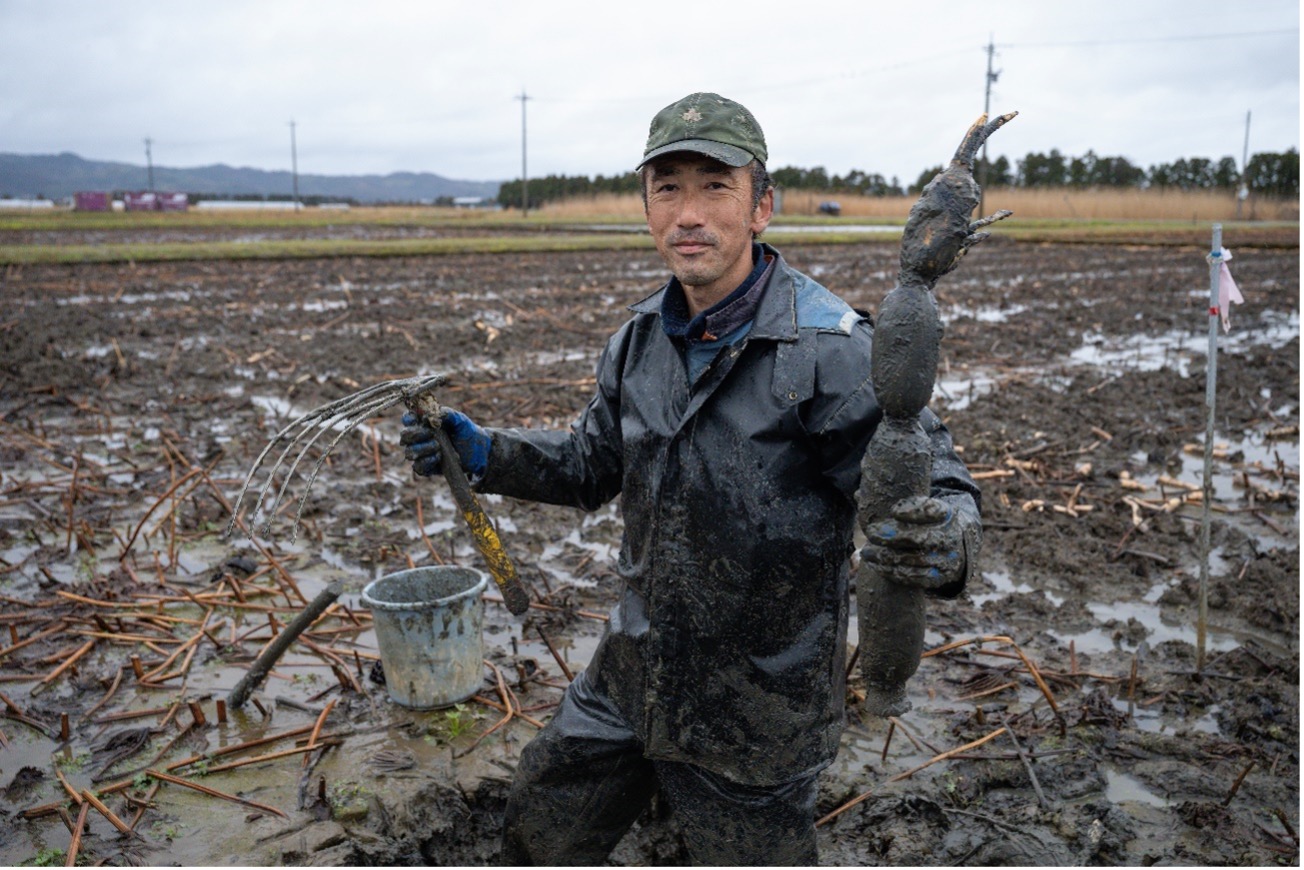
Mr. Yokoi is one of the few remaining farmers using the traditional “kuwa-bori” method in Kahokugata. Together with his father, Reiichi Yokoi, he cultivates “Kaga-renkon lotus root” in separate fields for both the “mizu-bori” and “kuwa-bori” methods. The Yokoi family harvests about 150 kg per day using the “kuwa-bori” method.
Unless there’s a lot of snow, they harvest no matter how cold it is, whether it’s rainy or windy. For the Yokoi family, harvesting takes place in the morning. They start around 7:30 a.m., digging knee-deep with hoes and carefully harvesting each “Kaga-renkon lotus root.” During the coldest periods, thick layers of ice, about 2 inches deep, form on the ground, and they may have to use chainsaws or hammers to break through the ice in order to dig. The heavy clay soil is quite tough, and just putting in and taking out their feet is a strenuous task.
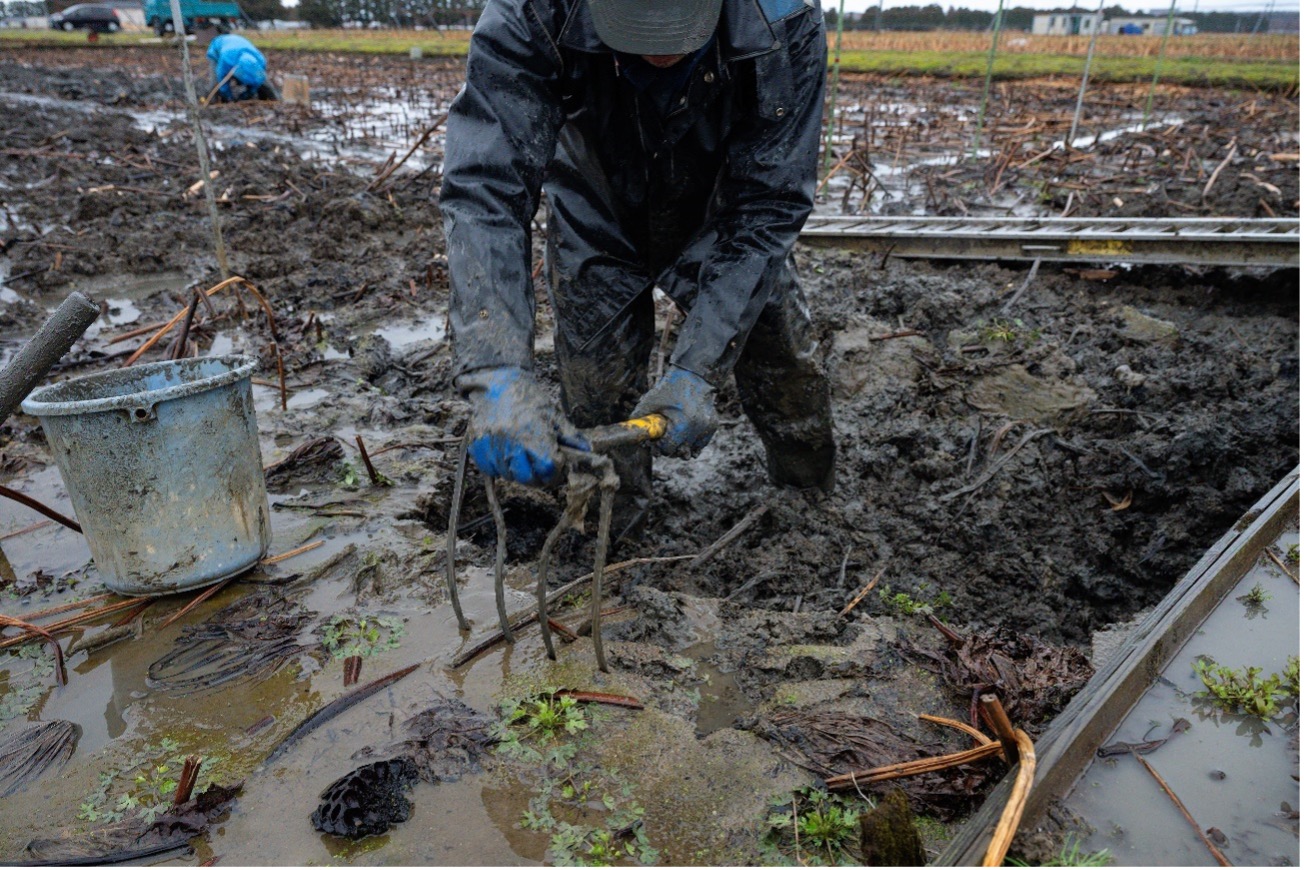
The lotus root is found in the soil beneath the withered, vine-like stems. Once the lotus root becomes visible by placing a hoe around the stem, it is cut off with a tool called “chōsami,” a blade similar to a machete. Handling the hoe is quite difficult, and it is said to take about three years to master the technique.
In the afternoon, sorting takes place in the warehouse. The mud on the lotus roots has a moisturizing effect, so it is never washed off, only gently wiped away with a towel. The mud around the nodes of the lotus root is carefully scraped off with a knife, and the ends are lightly trimmed to check for insect damage and to ensure that the root is firm. The lotus roots are then sorted by size and weight into grades such as “premium” or “superior” before shipment.
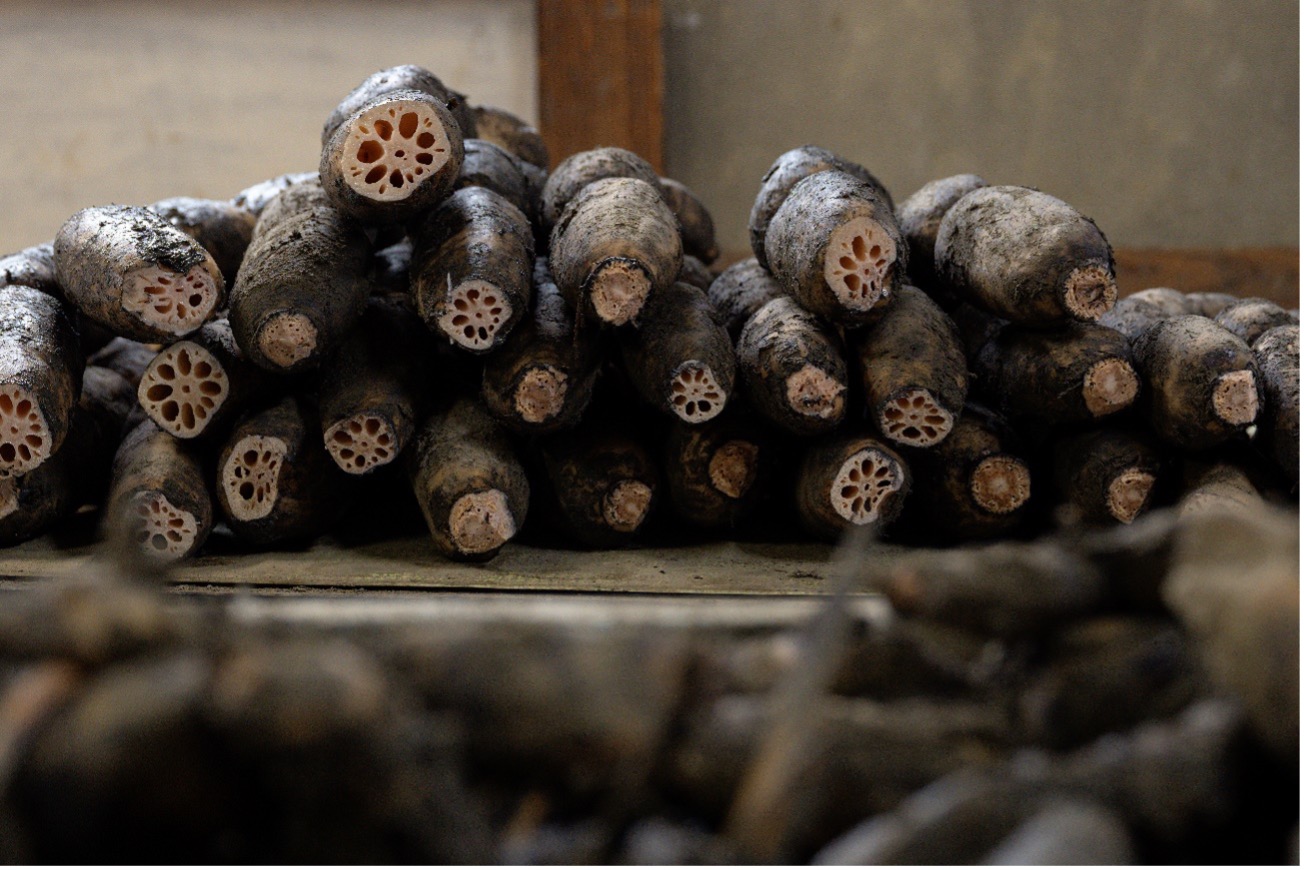
Why Kaga-renkon Lotus Root is “A Little More Expensive” Than Lotus Roots from Other Regions.
“Kaga-renkon lotus root” harvested by the “mizu-bori” method is shipped in a white, almost dirt-free state. However, lotus roots harvested by the “kuwa-bori” method, with the soil still intact, often last longer due to the moisturizing properties of the soil. As a result, they fetch a higher price nationwide. Nevertheless, many chefs insist on using the “kuwa-bori” “Kaga-renkon lotus root” with the soil still attached for its unbeatable freshness and flavor.
Mr. Yokoi says, “When I hear such feedback or see customers buying it right in front of me, no matter how hard the work is, I feel that growing ‘Kaga-renkon lotus root’ was worth it. I want to continue the ‘kuwa-bori’ method as long as I can.”
Harvesting using the “kuwa-bori” method not only helps keep the lotus roots fresh for a longer period but also prevents soil from entering the holes, which is a common issue with the “mizu-bori” method. In the case of “mizu-bori,” the water pressure can occasionally cause the lotus roots to break, allowing soil to enter the hole. While it is possible to wash off the soil and ship the lotus roots, doing so increases the likelihood of discoloration when the product reaches the consumer. As a result, both “Kaga-renkon lotus root” harvested by the “kuwa-bori” and “mizu-bori” methods adhere to strict sorting standards to ensure that any lotus root with soil in the hole is not shipped.
Due to these strict standards, about 10% of the production is not sold as “Kaga-renkon lotus root.” However, these are later processed into products and sold as lotus root croquettes and other items at the JA Kanazawa City headquarters, using the kitchen car introduced by the Kaga-renkon Lotus Root Association.
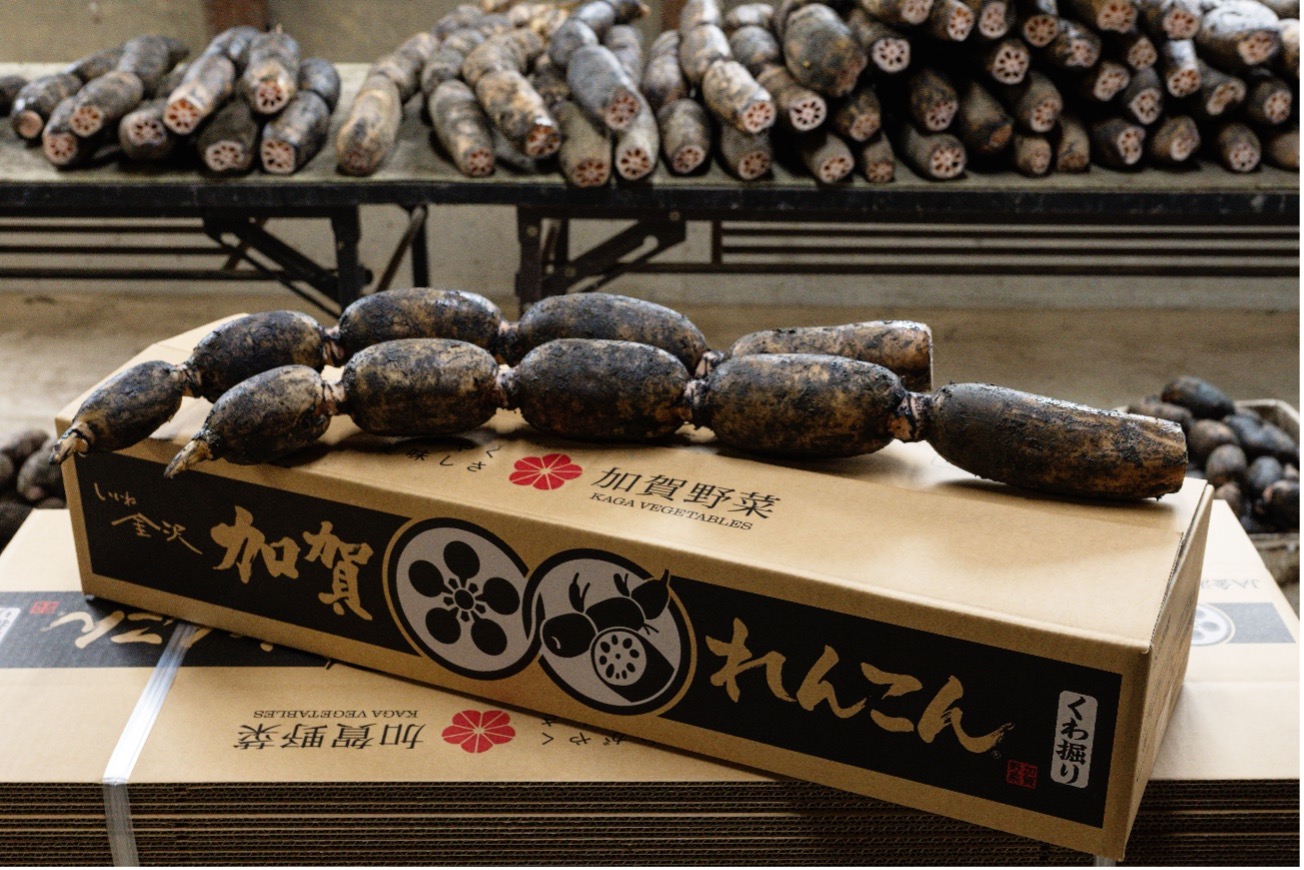
Wide Range of Ways to Enjoy: From Chips to Okonomiyaki
While “Kaga-renkon lotus root” is typically enjoyed in dishes such as lotus root steam, tempura, or kinpira, the Yokoi family’s thinly sliced, deep-fried “Kaga-renkon lotus root” chips are especially popular with children. “Grating it and adding it to okonomiyaki is also recommended. It has such a strong stickiness that you don’t need a binder. During the colder months, grating it and adding it to miso soup is a wonderful way to warm the body and soul.”
Not only is it delicious, but it is also believed to have beneficial health effects. The tannins and vitamin C, which are the active ingredients, are said to help lower cholesterol. In addition, drinking the pressed juice is believed to be effective in treating both stomach and duodenal ulcers, and it is also known to help stop diarrhea and improve overall digestion.
Grated, grilled, or fried—its versatility in various cooking methods makes the ever-reliable “Kaga-renkon lotus root” a star ingredient in any dish. The pleasure of eating it is enhanced by the hard work behind its harvesting, whether by the demanding “kuwa-bori” or “mizu-bori” methods, leaving a lasting impression of its exceptional flavor.